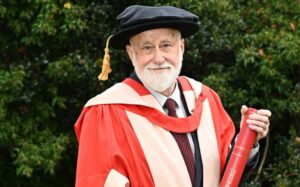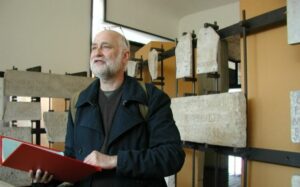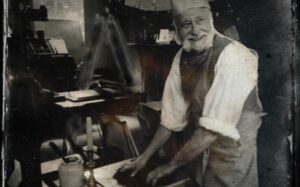With our summer graduation ceremonies currently underway, CONNECTED speaks to one alumnus who has been fortunate enough to celebrate graduation with Reading not once, but twice.
Martin Andrews first graduated from Reading in 1976 with a degree in typography and graphic communication. Then, in December 2023, Martin was invited back to receive an honorary doctorate degree in recognition of his outstanding contributions to the University and the town of Reading.
In his role as a designer at Reading Museum, Martin designed and installed the Riverside Museum at Blake’s Lock which won a Museum of the Year award. He also worked on the design for phase one of the Reading Town Hall restoration. Later in life, Martin came out of retirement to design a museum for Oxford University Press and a medical museum for the Royal Berkshire Hospital, as well as redeveloping the University’s own Ure Museum of Greek Archaeology.
 On receiving his honorary degree, Martin said: “Because I was so heavily involved in teaching I never had the time to do a PhD. I’m so grateful for all the opportunities I’ve had during my career, but I always felt a little bit disappointed that I hadn’t managed to convert my work into a PhD. I always felt my academic career hadn’t quite fulfilled itself. So when I was offered this honorary degree, it was a wonderful culmination of my degree and teaching.
On receiving his honorary degree, Martin said: “Because I was so heavily involved in teaching I never had the time to do a PhD. I’m so grateful for all the opportunities I’ve had during my career, but I always felt a little bit disappointed that I hadn’t managed to convert my work into a PhD. I always felt my academic career hadn’t quite fulfilled itself. So when I was offered this honorary degree, it was a wonderful culmination of my degree and teaching.
“I feel I have now completed my academic journey and I am so grateful.”
Memory lane
CONNECTED takes a walk down memory lane with Martin to discover more about how his time with the University, and his love affair with typography, all began.
Martin said: “I originally came to Reading to study fine art in 1970. But during my studies, I was told about the Department of Typography – set up by Professor Michael Twyman – who had decided that typography should be an entirely independent degree from art. This was incredibly rare at the time.
“I didn’t even know what the word typography meant. But when I visited the department on the Earley Gate side of campus and smelled the ink and saw the printing presses, I realised it was what I wanted to do. I just felt at home there. So in my second year I transferred to typography and never looked back.
“I was also really interested in museums and art galleries, and I was able to combine these two passions through the Real Jobs project. I designed an exhibition for the Museum of English Rural Life [MERL] called ‘The View from Beaford’ – a series of photographs of rural life taken by a man called James Ravilious.
“Luckily for me, the designer at Reading Museum came to the private view of this exhibition, and a week later he advertised a role which I managed to secure. So a week after I graduated I started at Reading Museum as the assistant designer, and a couple of years later I became the designer myself.”
From student to teacher
It wasn’t long before the family ties with the University became even stronger, when both Martin and his wife Verity – also a Reading graduate – began working at the University.
 Martin said: “I swore blind I would never be a teacher – my parents and sister were all teachers – but the call to return to Reading was too strong to resist. I became a lecturer in 1990 and loved teaching for the next 18 years.
Martin said: “I swore blind I would never be a teacher – my parents and sister were all teachers – but the call to return to Reading was too strong to resist. I became a lecturer in 1990 and loved teaching for the next 18 years.
“In 1992 while I was teaching, my wife Verity also returned to the University to study a part-time degree in English and classics. It took her five years to complete, and she did this while juggling home-life, two teenagers and a part-time job. She is inspirational and we are all so proud of her. In 1996 Verity became a Library Assistant, before becoming an Archives Assistant in 2000. Verity became an expert in the archives, helping researchers and working on their publications with them.”
One of Martin’s favourite things about teaching typography was being able to recreate his favourite memories of the course for a whole new generation of students. He said:
“One of my stand-out memories from being a student at Reading were the trips Professor Twyman would take us on – we went on study trips to Rome and Florence which had a huge impact on me. So when I became a member of staff I wanted to recreate these amazing experiences for my students.
“Every year I helped to organise field trips to these incredible cities with around 60 students, teaching from 8am to 5pm every day and I absolutely loved it. We would study inscriptional lettering, ancient lettering and the development of the alphabet in Rome, and in Florence we studied how the Renaissance changed lettering. It was such brilliant bonding time with the students.”
A hopeless collector
Since retirement Martin has been able to continue his love for typography through his many and varied hobbies.
He said: “I’m a painter and printmaker, and in recent years I’ve started working with ceramics so I guess I’m also a potter. I’ve been the President of the Reading Guild of Artists and have been on the Reading arts scene for many years. I’m also a hopeless collector.
“I collect printed ephemera, which is the stuff that gets thrown away – like posters and tickets. Professor Twyman believed that if you’re going to be a good designer you need to know about designing in the past as well as the future, and that ephemera is really important because it informs social history in such a strong way.”

Martin has also ventured into the world of television. He said: “I was involved with a show which centred around the reconstruction of the Guttenberg’s first printing press, presented by Stephen Fry. I’ve also been involved in the Bridgerton printing scenes and other shows including The Great, Outlander, Philomena Cunk, and Great British Railway Journeys with Michael Portillo. Working on television has been a funny little spin-off for me but it’s been a great experience.
“Everything I’ve done in my studies and career has been a privilege, but none more so than having spent my working life with young people. It was a great honour to be able to have a very tiny influence on their lives.
“Now I’m retired I really miss working with students. Lecturing made me feel perpetually young and I learnt from my students as well.
“I’m ever so lucky. I’ve had such a good life.”
Special memories for Martin of his time at Reading are of getting engaged and married to his wife, Verity. They recently celebrated their Golden Wedding Anniversary and shared their UoR Love Story with CONNECTED.




